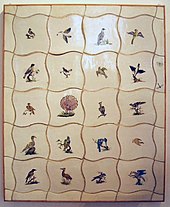Stralsund faience manufactory

The Stralsund Fayencenmanufaktur ( Swedish Strålsunds Porslinsfabrik ) was a factory for faience production in Stralsund that existed from 1755 to 1792 .
The factory was the granting of the concession of the City Council on September 19, 1755 by the merchant Joachim Ulrich Giese founded (1719 to 1780). Initially, two kilns were operated in the manufactory's buildings (in Tribseer Strasse 24 a ). A third oven was added later. It developed into one of the largest ceramic manufacturers in the Baltic region.
Giese owned land on the island of Hiddensee , where he had clay mined in addition to running a herring salting factory. The nature of the clay was investigated on Giese's behalf by the protophysicist Bernhard Nicolaus Weigel. Twelve workers were employed on Hiddensee in 1757 with the mining and transport of the clay to Stralsund, 57 workers in the factory (including Johann Georg Buchwald ).
In addition to the manufacture, Giese maintained the herring salting factory mentioned, but also a cloth manufacture (1763–1766) and a bank account; He also leased the Stralsund Mint from 1758 to 1763. These businesses prevented him from advancing the establishment of the manufactory. In 1766 he therefore sold the company to Johann Ehrenreich. He previously headed the Swedish factory in Marieberg (1759–1788) on the Stockholm island of Kungsholmen and brought 40 lathe operators, painters and other craftsmen as well as a pastor with him to Stralsund. In 1769, 77 workers were already employed in the company, making this factory the one with the highest number of employees in Stralsund. Under Ehrenreich, the faience factory became one of the leading of its kind in Central , Northern and Northeastern Europe .
The company was affected by the explosion of the Köpken Tower at Tribseer Tor in 1770. The only 22 workers left were partially rewarded with the company's products instead of money. After further changes of ownership in 1772 and 1786, the manufactory was forcibly administered by its creditors from 1788 to 1792.
In the Stralsund Museum (cultural history museum of the city of Stralsund), in the St. Anne's Museum in Lübeck , in the Pomeranian State Museum in Greifswald and in museums in Stockholm and Copenhagen , numerous products of the manufacture can be viewed. A few pieces are shown in the Hiddensee Local History Museum.
literature
- Gesine Schulz-Berlekamp: Stralsund faience 1755–1792. Henschel, Berlin 1991, ISBN 3-362-00605-1 (exhibition catalog).
- Gesine Schulz-Berlekamp: Stralsund faience. Photos Volkmar Herre . Rügen-Verlag, Putbus 1993, ISBN 3-9803522-0-X .
Web links
Individual evidence
- ↑ Strålsund faience . In: Encyclopedia Britannica . ( britannica.com [accessed December 20, 2017]).

